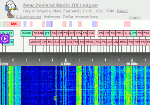THE HOBBY OF DX-ING
From the 1948/49 “Lamphouse” Annual
THE term DX is an abbreviation of the word distance as used in the amateur radio transmitters’ code, and those who indulge in the pastime of distant listening became known as dxers.
There are now DX Clubs established all over the world and the oldest club in Australasia is the New Zealand DX Club, Inc. This club had its beginnings way back in 1927.
Engineers of the stations throughout the world wonder how well their signals are being received and welcome letters from distant parts. Cards are called verifications as is any answer returned to the DX-er by the station confirming that the listener has really heard and logged that station. And it is the verification that is the basis of the DX hobby. Members try to see how many stations they can verify, while in the various branches of the N.Z. DX Club regular competitions are held and the verifications are judged on power and distance to ascertain the “Best-of-the-Month,” etc.
As mentioned earlier correct and intelligent reports are appreciated, for such are of great value to the Station’s chief engineer.
At each session at the dials, write in your “rough” note pad the day, date and time, and when a new signal is picked up jot down the frequency and particulars of items and advertisements heard.
About half an hour’s programme is sufficient. List the time of each item and see your watch is correct. Other details to be noted are the strength and quality of the signal and any fading or interference present.
When writing your report put your name, address and the date at the top of the page. Give the time in New Zealand Daylight Saving time (12 hours ahead of G.M.T.) and also convert into the station’s local time and date. Fiji has the only stations on the same time belt as New Zealand. Several countries observe Summer Time, so if in doubt quote their Standard Time, or G.M.T. Volume can be graded as exceptionally loud, loud, moderately loud, fair or weak. Or the “R” and “QSA” code given in this article may be used, as it is internationally known. It is important to give details of your receiver, aerial and earth systems, and weather conditions during reception. Other facts to be stated are fading (steady, light, severe, rhythmic, irregular, or nil), also note the depth and duration of fades. Or if from another station try to name the offender. Tone, (say whether good and clear, harsh or mellow, rough and garbled, deep, or high). Give particulars of any peculiarity such as gongs sounding, clocks chiming, interval signal, whether man or lady announcer, etc. Write clearly and don’t exaggerate by saying volume was “great” when you had almost to sit in the speaker to hear anything. Perhaps someone else may write and give a reverse report to your own, hence your first disappointment when no verification is forthcoming.
AUDIBILITY.
Ri—Faint Signals. R6—Good.
R2—Weak Signals. R7—Strong Signal
R3—Can be copied. R8—Very Strong.
R4—Fair Signals. R9—Overloading.
R5—Moderately Strong.
READABILITY.
QSA1—Unreadable.
QSA2—Readable Occasionally.
QSA3—Readable with Difficulty.
QSA4—Readable.
QSA5—Perfectly Readable.
Further particulars may be obtained from the Editor, N.Z. “DX-tra,” 5 Dublin Street, Invercargill. (Note the home of Merv Branks)




